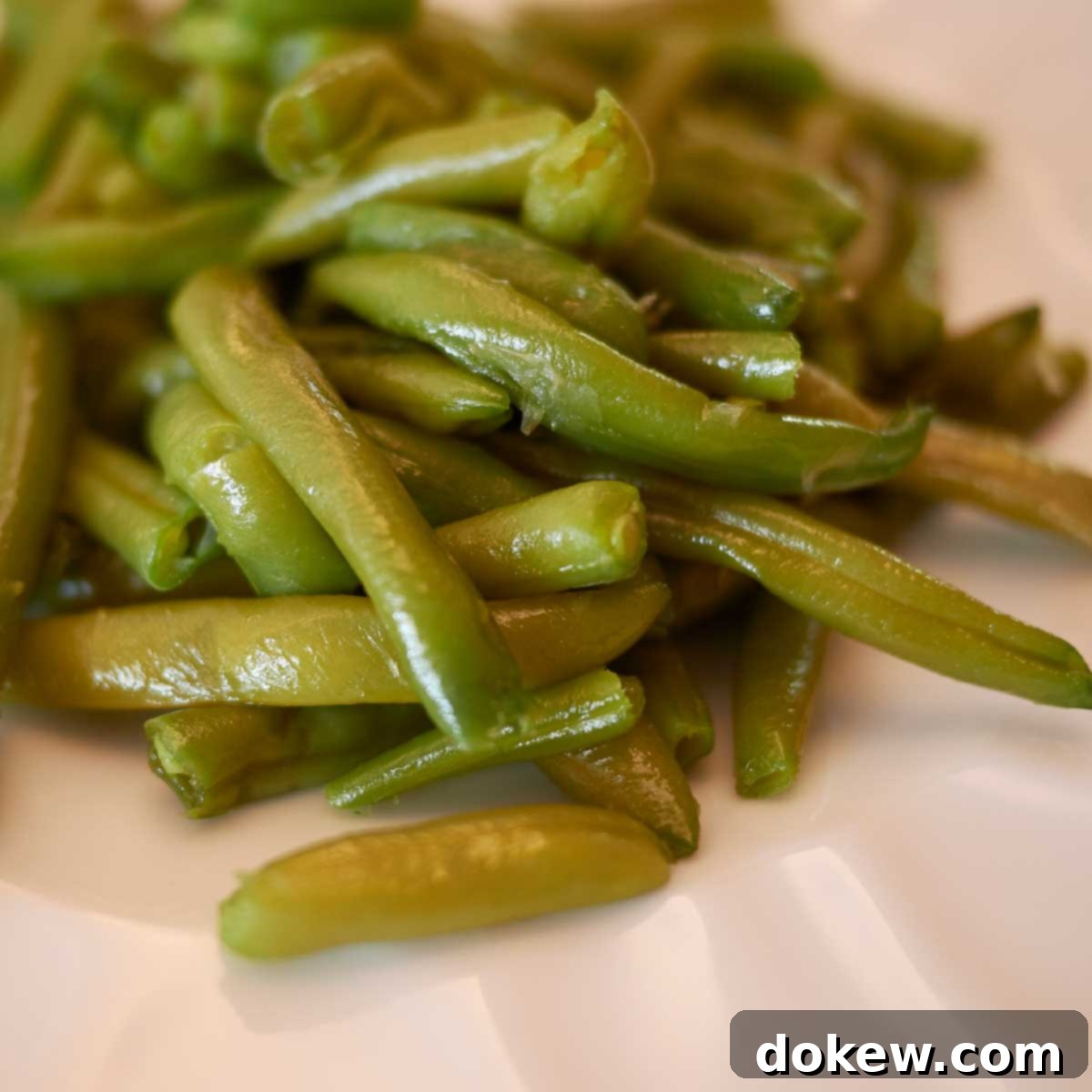Slow Simmered Green Beans: Transform Canned into an Irresistible, Buttery Side Dish
Discover the simple secret to turning ordinary canned green beans into an extraordinary, rich, and deeply flavorful side dish. With just two ingredients and the magic of slow simmering in butter, these green beans become incredibly tender, infused with a luxurious depth that will have everyone asking for seconds. Forget bland, watery canned vegetables; this method unlocks a comforting, old-fashioned taste reminiscent of Grandma’s kitchen. Perfect for holiday meals, weeknight dinners, or any occasion where you crave a truly satisfying vegetable side. It’s an easy, low-effort recipe that yields incredibly high rewards in terms of taste and texture.
Recipe

Slow Simmered Green Beans in Butter
Add to Shopping ListGo to Shopping List
Ingredients
- 38 ounces Blue Lake green beans, canned, undrained
- 4 tablespoons unsalted butter, cut into pieces
Instructions
-
Combine the undrained canned green beans and the butter pieces in a sturdy pot or Dutch oven. Ensure the butter is distributed evenly.
-
Place the pot over medium heat and bring the mixture to a gentle simmer. Once simmering, reduce the heat to the lowest possible setting. The goal is a very slow, gentle bubble, not a rolling boil.
-
Cover the pot and slow cook for approximately 4 hours. Check periodically (every hour or so) to ensure there is still liquid in the pot. If the liquid evaporates too much and the beans start to dry out, add a small amount of water (1/4 to 1/2 cup at a time) to maintain a gentle simmer. Stir occasionally to prevent sticking and ensure even cooking.
-
After 4 hours, the green beans should be incredibly tender and deeply infused with the buttery flavor. Taste and adjust seasoning with salt and pepper as needed. Serve hot as a delightful side dish.
Nutrition per serving
Share
Pin
Why Slow Simmering Canned Green Beans is a Game Changer
You might be wondering why anyone would cook canned green beans for four hours. The answer lies in the incredible transformation that occurs during this slow cooking process. Canned green beans, while convenient, often lack the deep, earthy flavor and tender texture that truly makes a vegetable side shine. Boiling them quickly often leaves them tasting tinny and bland. Slow simmering, however, works magic.
Over several hours, the green beans break down, becoming exceptionally tender – almost melt-in-your-mouth. More importantly, the starches in the beans are released and combined with the butter and the small amount of liquid they come in, creating a rich, savory broth that re-infuses into the beans. This process allows the butter’s flavor to deeply penetrate every single bean, creating a complex, savory profile that simply cannot be achieved with quicker cooking methods. It’s a method that elevates a humble pantry staple into a dish that tastes like it took far more effort and fresh ingredients than it actually did. It brings out a nostalgic, home-cooked essence that makes this side dish incredibly comforting and satisfying. This low and slow technique essentially braises the beans, intensifying their natural sweetness and savory notes while achieving an unparalleled tenderness.
Choosing Your Canned Green Beans
For this recipe, the quality of your canned green beans matters, but don’t overthink it. “Blue Lake” green beans are often recommended for their consistent quality and good texture after cooking. However, any good quality canned cut green beans will work. Look for cans that are not dented or bulging. The “undrained” instruction is crucial here; the liquid in the can is essential for the slow simmering process, helping to create that flavorful, buttery broth. Avoid French-style green beans for this recipe, as their thinner texture might break down too much during the extended cooking time.
The Magic of Butter (and Other Fats)
Butter is key to this recipe’s rich flavor profile. It not only adds a luxurious, creamy taste but also acts as a medium for slow cooking, carrying flavor deep into the beans. Using unsalted butter allows you to control the final seasoning precisely. If you only have salted butter, simply adjust the amount of added salt later. While butter is traditional and highly recommended, you can experiment with other fats for different flavor profiles. Bacon fat, for instance, would add a smoky, savory depth, making these beans even more robust. Olive oil could be used for a dairy-free option, though it won’t yield the same rich, comforting taste as butter.
Tips for the Best Slow Simmered Green Beans
- Monitor Liquid Levels: The most important tip is to check on your beans periodically. While the goal is a low simmer, liquid can evaporate over four hours. Add a little water (or even vegetable broth for more flavor) if the pot seems to be getting dry. You want enough liquid to keep the beans simmering gently without scorching.
- Season Thoughtfully: Canned green beans often have some salt already. Taste the beans before adding extra salt. You can always add more, but you can’t take it away! Freshly ground black pepper is also a wonderful addition, as are a pinch of garlic powder or onion powder for extra depth.
- Pot Choice Matters: A heavy-bottomed pot or Dutch oven is ideal. This type of cookware distributes heat evenly and retains it well, which is crucial for successful slow simmering and preventing scorching.
- Don’t Rush It: The “slow” in slow simmered is there for a reason. Resist the urge to turn up the heat to speed things along. The long, gentle cook time is what develops the incredible tenderness and rich flavor.
- Lid is Your Friend: Keep the pot covered tightly to trap steam and prevent excessive liquid evaporation. This helps the beans cook evenly and stay moist.
Variations & Add-ins to Elevate Your Dish
While delicious in its simple, classic form, these slow simmered green beans are also a fantastic canvas for additional flavors. Get creative and customize them to your liking:
- Smoky Bacon: Cook 2-3 slices of bacon until crispy, then crumble and stir into the beans during the last hour of cooking. You can even use a tablespoon or two of the rendered bacon fat in place of some butter for an extra layer of flavor.
- Aromatic Onions & Garlic: Sauté half a chopped onion and 2-3 cloves of minced garlic in the butter for a few minutes before adding the green beans. This adds a wonderful aromatic base.
- Spice It Up: A pinch of red pepper flakes can add a subtle kick. Smoked paprika would also be a delicious addition for a deeper, warmer flavor.
- Herbs: Fresh or dried herbs can enhance the flavor. A sprig of fresh thyme or a bay leaf added during simmering, or a sprinkle of fresh parsley or dill before serving, would be excellent.
- Broth Boost: Instead of water, use a low-sodium chicken or vegetable broth when adding extra liquid, to further enhance the savory notes.
- A Touch of Sweetness: For a slightly different profile, a tiny pinch of sugar or a splash of maple syrup can be added, particularly if you enjoy a touch of sweet and savory.
Serving Suggestions
These buttery, slow-simmered green beans are incredibly versatile and pair well with a wide variety of main courses. They are a classic comfort food side, perfect alongside:
- Roasted chicken, turkey, or pork loin
- Meatloaf or Salisbury steak
- Grilled fish or hearty vegetarian mains
- Holiday feasts, adding a touch of traditional warmth
- Simple weeknight dinners where you want a reliable and delicious vegetable
The rich flavor means they can stand alone as a simple vegetable offering, or complement more complex dishes without being overwhelmed.
Storage and Reheating
Leftover slow-simmered green beans store beautifully. Allow them to cool completely before transferring to an airtight container. They will keep in the refrigerator for up to 3-4 days. To reheat, gently warm them on the stovetop over low heat, adding a splash of water or broth if needed to restore moisture. You can also reheat them in the microwave, stirring occasionally, until heated through. The flavors often deepen even further after a day or two, making them an excellent make-ahead side dish.
Troubleshooting Common Issues
- Beans are too watery: If your beans are too watery after 4 hours, simply remove the lid and continue to simmer on low heat, stirring occasionally, until the excess liquid has evaporated to your desired consistency. The flavor will also concentrate further.
- Beans are not tender enough: If they haven’t reached your desired tenderness, continue simmering for another 30 minutes to an hour, checking the liquid levels and adding more water if necessary. Different brands of canned beans can vary slightly.
- Not enough flavor: Taste and adjust! A little extra salt, a dash of black pepper, or a pinch of garlic powder can make a big difference. Consider adding a bouillon cube if you prefer a more intense savory taste.
This recipe for slow-simmered green beans in butter is a testament to the fact that sometimes, the simplest ingredients and a little patience can create the most memorable and comforting dishes. It’s a reminder that even pantry staples can be transformed into something truly special with the right technique. Give it a try, and let these buttery, tender green beans become a beloved staple in your home.
